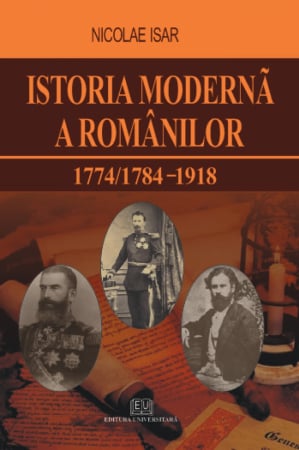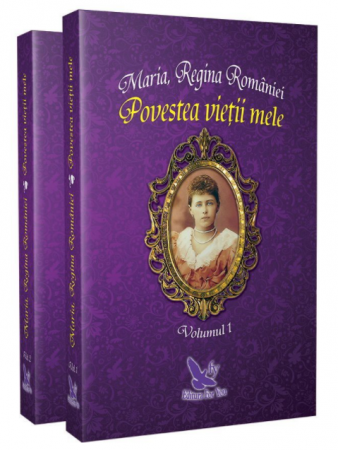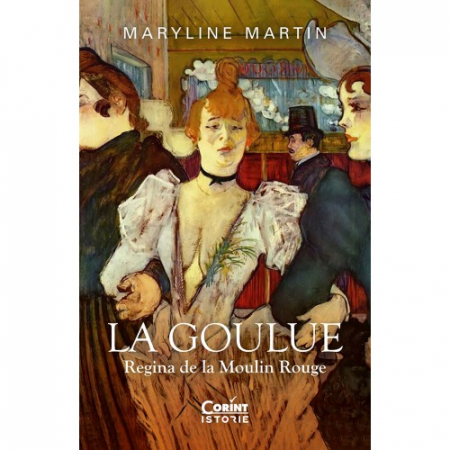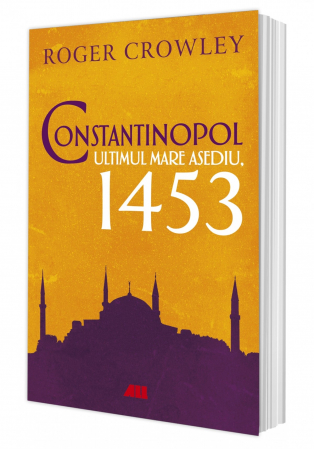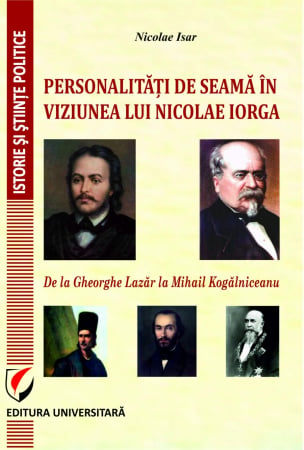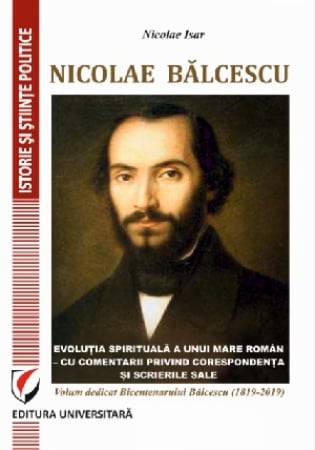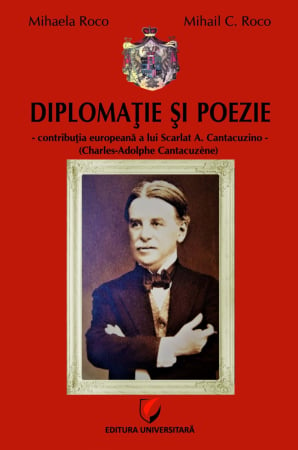ISBN: 978-606-591-304-2
DOI: 10.5682 / 9786065913042
Publisher year: 2011
Edition: I
Pages: 358
Publisher: Editura Universitară
Author: Adrian Ignat
- Description
- Download (1)
- More details
- Content
- Authors
- Reviews (0)
The topic chosen to be treated, dedicated contribution factor to the Greater Union Church, abundantly justified for what he represented the union in 1918 and our history as a nation for our future as a nation state. I wanted my approach certain aspects of the issue to be reviewed, clarified and presented in a form to complete knowledge of the role played by Romanian Church - Greek Orthodox and Catholic - the great national act of December 1, 1918.
Throughout our history has brought Romanian Church mite to the prosperity of the Romanian people by word and deed to the prosperity of the Romanian people. Under the cloak Church Romanian culture and spirituality could increase, bringing forth good fruit in due time, the church porch for a long time, the Romanian school was able to develop, under the protection of her Romanian patriots expressed their ideas, with prayer and Romanian soldiers and all its blessings drive fighters were able to carry out their ideals.
Nicolae Iorga say that "history is a Supreme Court where the judge acts of peoples, nations and all mankind". In the long struggle for independence and unity of the Romanians, never an idea, an ideal not polarized with such force the will of an entire nation, as the difficult years of World War. Generated because the unit acts of heroism and bravery committed by the Romanian army in the battles over the Carpathian passes in battles to defend territory and Wallachia, in the great confrontations of Marasti, Marasesti and Oituz in the summer of 1917. National ideal was present and led the political and diplomatic actions, deeds of arms, artistic and literary creation of that era. Political activity and propaganda, held abroad, especially in France, Italy, USA, England etc., Was also outstanding in those years.
1918 was the year in the history of our great accomplishments in the realm of national victorious culmination of a long line of waiting and surrendered the fight and sacrifice for a belief to an ideal perfection unitary national state. Romanian nation has made its century-old dream favorable international circumstances, but under favorable whose sons have bled abundantly. Documents from that time show of patriotism charged atmosphere in which the Romanian people has achieved national unity. Decisions of the union in 1918 were taken into the general representative bodies, formed on a generally democratic. This decision gave these quasi-plebiscitary character.
Motive was the Great Union of 1918 the Romanian people, as a whole. Vasile Goldi, one of the militants to unify the full state, said: "Romania Mare is the creation of political parties or the army, but of historical evolution, which can not be stopped by any human force." And Nicolae Iorga, with its incomparable penetration force, said that the two main stages, the Romanian people and has achieved perfect unity - 1859 and 1918 - marked "consecration in the reality of a state of consciousness that has always existed from the very origin of our nation. "
In the first chapter of the thesis ("Church and Romanianism. General"), we explore the various views on the relationship between the Church and the Romanian people. We have shown that the Orthodox Church in Romania is an indigenous church, dedicated to genealogy and her character of a specific tradition. Here, between Church and State, the Byzantine model, and there is a symphony of events clearly disturbed only incidental. More than in other nations, to us, Romanian, symbiotic relationship between Orthodoxy and nations not only undeniable, but its origins and support in our own ethnogenesis. Therefore the link between the two elements is much stronger and can not be undone. Whenever the life of the Romanian people there was a turning point, or when they reached certain ideals precious of all Romanians, the Church's life and ancestral mutations have been generated emulations church spiritual fulfillment.
Chapter II of the paper ("The Contribution of the Church in historical Romanian provinces under foreign control in promoting national idea, until 1914") shows struggle Romanian Churches in Transylvania (Orthodox and Greek Catholic Church), Bessarabia (Church ) and Bukovina (Orthodox Church). In Transylvania, although made up the overwhelming majority of the population, Romanians were considered "tolerated" the land of ancestors. In the fight for the rights of the Romanian Orthodox Church and, as part of the Romanian faithful union with Rome, Greek-Catholic Church have said that fighting for the rights of Romanian believers. The paper presents the contributions of people of the Church, Orthodox (Andrei Saguna, Demetrius Comsa, Daniel Popovici-Barcianu, Miron novel, John Meţianul, Miron Cristea, etc..) And Greek Catholics (Micu Klein, Grigore Maior, Iuliu Hossu, John Bob, John Para, Dimitrie Radu Vasile Hossu, Victor Mihali, etc..) the rights and promote Romanian national idea by the church and school.
In chapter III, entitled "The Church in the service of national idea during World War I (1914-1918)" is shown the contribution of the Church and its servants in the Old Kingdom on the battlefield and in the Romanian army medical service, suffering endured by priests and ministers of the Church temporarily occupied territory (killed, deported, arrested, imprisoned, abused, refugees, etc..) pillaging soldiers occupying powers on goods and treasures, churches, public aid for religious service of the army, etc.. However the situation is presented and its servants Romanian Church in Transylvania and Banat, Bessarabia and Bukovina, suffering endured, but also enhance national sentiment among Romanians' struggle for national unity and organization.
Events of 1918, which led to the Greater Union, are reserved Chapter IV, entitled "The Church and the Great Union of 1918". Internal conditions are presented in each Romanian historical province in which they decided to unite, the role of clergy in the Church and the union's involvement in the events of March 1918 in Bessarabia, Bukovina November and December in Transylvania. It is also considered the complex world in which union took decisions in Chisinau, Chernivtsi and Alba Iulia.
The last chapter ("Unification Church - factor to strengthen political unity of the Romanian state") analyzes the events related to the establishment of a unified organization of the Orthodox Church in Romania after the Union, as each historical province united in their organization had its own church. Initiative in this direction in the new territories belonged to the Orthodox Churches united with the country, the Orthodox Church in Transylvania and Bessarabia, supported by other churches Romanian provinces. This process, initiated since 1919, has seen perfection in 1925 by creating the Romanian Patriarchy and choosing the Patriarchal Throne Metropolitan Miron Cristea.
For carrying out the work we studied documents in the Holy Synod Chancellery Archives in Bucharest, Greek Catholic Metropolitan Archive Blaj, Archive Romanian Orthodox Episcopate of Arad, Banat Metropolitan Archives (Diocese Caransebes), the clergy Military Inspectorate was in Romanian Military Archives in Pitesti . I also used several collections of documents, of which I want to point out the first eight volumes published until 1989 Scientific and Encyclopedic Publishing House, dedicated to the events of 1918. We also investigated a number of publications (reminiscent of those "Bee", "Christian culture", "Gazeta Transylvania", "Romanian Telegraph" and others) and works with general or special Boldur signed by Alexandru Ion Bria, Petre Cazacu, Nicholas Ciachir, V. Curticăpeanu, Stefan Pascu, Onesiphorus Ghibu, Vasile Goldi, Nicolae Iorga, John Lupas, Nestor Vornicescu, Ion Nistor, Mircea Păcurariu, Zenovie Pâclişanu, TV Pacatian, Anthony Plamadeala, Daniel Prodan, Maria Somes, Dumitru Stăniloae and others.
Also during this thesis we used the works of theologians and historians of the Romanian Orthodox Church and the Greek Catholic Church, such as Prof. Dr. Dumitru Stăniloae, Prof. Dr. Mircea Păcurariu, Rev. Dr. John Lupas, Ioan Moraru, Fr Zenovie Pâclişanu, Maria Somes, etc.., which allowed me to have a broad perspective on church involvement in society and in the history of the Romanian people. Without involvement of the Church hard in achieving these events, as well as religious goals of the utmost importance, after political events, current Romanian society was deprived of all future events.
In closing, I want to thank everyone who helped me to manage to finish the project that I undertook three years ago, and my family first.
Thanks also D-l Univ. Dr. John Calafeteanu data for guidance and support I have always found her Ladyship.
-
Aportul Bisericii la Marea Unire de la 1 Decembrie 1918
Download
Marea Unire din 1918 reprezintă unul dintre acele momente din istoria naţională care va atrage permanent interesul istoricilor. Şi asta nu numai pentru că evenimentele din acel an de la Chişinău, Cernăuţi şi Alba Iulia încununează un proces de importanţă fundamentală pentru noi ca români. Şi nici pentru că permanent apar informaţii ce îmbogăţesc sau luminează aspecte mai puţin cunoscute sau chiar necunoscute ale Marii Uniri. Ci, pentru că simţim permanent nevoia – astăzi mai mult decât oricând – să ne raportăm la momente de glorie ale istoriei noastre, să ne recâştigăm încrederea în noi – ca indivizi şi ca naţiune – şi să putem privi cu mai multă încredere spre viitor.
Aceştia au fost şi factorii care m-au determinat să accept propunerea doctorandului Adrian Ignat de a realiza o lucrare de doctorat cu tema „Aportul Bisericii la Marea Unire de la 1 Decembrie 1918”. Doctorandul însuşi mărturiseşte că a făcut această opţiune convins fiind că „tematica aleasă [...] se justifică cu prisosinţă pentru ceea ce a reprezentat Unirea din 1918 pentru istoria noastră ca naţiune şi pentru viitorul nostru ca stat naţional”.
Planul lucrării este bine structurat, menit să evidenţieze rolul important al Bisericii în Marea Unire din 1918, ca o încununare a activităţii de secole a acestei instituţii, în sprijinirea promovării ideii naţionale în toate provinciile istorice româneşti.
După „Introducere”, în care autorul face o prezentare a lucrării şi bibliografiei folosite, în primul capitol, intitulat „Biserica Ortodoxă şi românitatea. Consideraţii generale”, doctorandul analizează rolul Bisericii Ortodoxe în istoria poporului român şi raportul dintre Biserică şi naţiune în spaţiul românesc. Factorul creştin – arată autorul – este prezent încă din perioada procesului de romanizare a triburilor daco-geto-tracilor, încât se poate afirma că latinitatea şi creştinismul se află la originea poporului român. În continuare, în cadrul capitolului sunt dezbătute diverse opinii privind problema continuităţii româneşti, rolul Bisericii în dezvoltarea culturii române, raporturile Biserică-Stat în Ţările Române („simfonia bizantină”) etc. Strânsa legătură între destinul Bisericii Române şi cel al Ţărilor Române este susţinută de autor prin paralelismul între împlinirile în plan statal şi bisericesc de-a lungul secolelor. Astfel, el arată că întemeierea statelor feudale româneşti a fost urmată la scurt timp de întemeierea primelor mitropolii, unirea din 1859 a însemnat şi unirea celor două Biserici sub un mitropolit primat, independenţa cucerită în 1877-1878 a fost curând urmată de recunoaşterea autocefaliei bisericeşti (1885), iar Marea Unire din 1918 a fost urmată în plan bisericesc de unificarea bisericească şi ridicarea Bisericii Ortodoxe Române la statutul de Patriarhie (1925).
În capitolul al doilea al lucrării („Contribuţia Bisericii din provinciile istorice româneşti aflate sub stăpânire străină la promovarea ideii naţionale, până la 1914”), în peste 150 de pagini autorul prezintă acţiunea Bisericilor româneşti din Transilvania, Banat, Basarabia şi Bucovina pentru păstrarea identităţii naţionale, cucerirea de drepturi politice şi greutăţile pe care le-au avut de învins. În Transilvania Bisericile româneşti – Ortodoxă şi Unită – s-au afirmat ca luptătoare pentru drepturile politice, culturale şi, desigur, religioase ale românilor. În lucrare sunt prezentate contribuţiile aduse în afirmarea românismului în Ardeal, atât de reprezentanţi ai Bisericii Ortodoxe (Andrei Şaguna, Miron Românul, Miron Cristea etc.), cât şi Greco-Unite (Inochentie Micu Klein, Grigore Maior, Iuliu Hossu etc.).
În Banat, în Bucovina şi în Basarabia, în condiţii deosebit de grele, Biserica Ortodoxă a reuşit să se opună politicilor de deznaţionalizare ale autorităţilor ocupante, să dezvolte cultura naţională, să cultive limba românească. Autorul aminteşte nume de slujitori ai Bisericii care s-au remarcat în lupta naţională, precum mitropolitul Veniamin Costache, Gavril Bănulescu-Bodoni, episcopul Vladimir din Basarabia, sau Dosoftei Herescu, mitropolitul Silvestru Morariu-Andrievici, Vladimir Repta şi alţii în Bucovina.
În capitolul al treilea („Biserica în slujba ideii naţionale în anii primului război mondial, 1914-1918”), doctorandul analizează principalele evenimente din România şi teritoriile româneşti aflate încă sub stăpânire străină în anii primului război mondial. Încă în ajunul războiului – se arată în lucrare – în rândul românilor era larg împărtăşită credinţa apropiatei realizări a Unirii, pe care Biserica şi slujitorii săi nu numai că şi-o însuşeau, dar o şi promovau, de o parte şi de alta a Carpaţilor, în ciuda pericolelor la care se expuneau slujitorii ei.
În Vechiul Regat slujitorii Bisericii Ortodoxe Române s-au aflat în anii 1916-1918 pe câmpul de luptă, ca preoţi confesori (în august 1916 fusese creat Serviciul Religios de pe lângă Marele Cartier al Armatei Române, al cărui şef a fost numit preotul Constantin Nazarie) sau în calitate de slujitori în serviciul sanitar, mulţi dintre ei pierzându-şi viaţa. În aceeaşi perioadă, pe teritoriul ocupat vremelnic de Puterile Centrale, preoţi şi alţi slujitori ai Bisericii au suferit un regim de teroare, au fost ucişi, deportaţi, arestaţi, maltrataţi, închişi, obligaţi să se refugieze în teritoriul liber etc.; ei s-au opus jafului ocupanţilor asupra locuitorilor, cât şi a bunurilor şi odoarelor bisericeşti.
Totodată autorul prezintă situaţia grea a Bisericii Române şi a slujitorilor ei din Transilvania, Banat, Basarabia şi Bucovina, care în ciuda tuturor vicisitudinilor nu au renunţat la lupta lor în plan naţional, au păstrat vie credinţa românilor în victoria finală, dincolo de situaţia existentă pe front la un moment dat.
În capitolul al IV-lea al lucrării, intitulat „Biserica şi Marea Unire din 1918”, doctorandul analizează evenimentele legate de împrejurările interne şi internaţionale în care în martie, noiembrie şi decembrie 1918 la Chişinău, Cernăuţi şi Alba Iulia, Adunările reprezentative ale românilor din Basarabia, Bucovina şi Transilvania au proclamat unirea acestor teritorii româneşti cu Ţara. Pe baza unor informaţii documentare bogate, parţial inedite, doctorandul prezintă rolul Bisericii româneşti din cele trei provincii româneşti în organizarea acestora ca „ţări româneşti” şi implicarea Bisericii şi slujitorilor ei în pregătirea evenimentelor din 27 martie/9 aprilie, 15/28 noiembrie şi 18 noiembrie/1 Decembrie 1918 din Chişinău, Cernăuţi şi, respectiv, Alba Iulia.
În capitolul al V-lea („Unificarea bisericească – factor de întărire a unităţii politice a statului român”) autorul analizează procesul de unificarea a „Bisericii dominante în statul român” – cum era calificată Biserica Ortodoxă în Constituţia din 1923 (despre Biserica greco-catolică se spunea „că are întâietate faţă de celelalte culte”) – proces apreciat de doctorand ca factor de întărire a unităţii politice a statului român. Aceeaşi semnificaţie a avut şi ridicarea scaunului arhiepiscopal şi mitropolitan al Ungrovlahiei la rangul de scaun Patriarhal, hotărâre luată de Sfântul Sinod al Bisericii Ortodoxe Române la 4 februarie 1925 şi aprobată de Senat la 12 februarie şi de Camera Deputaţilor la 17 februarie 1925.
Un capitol de „Concluzii” şi o listă cu „Bibliografia” folosită de autor la redactarea lucrării încheie teza de doctorat.
În concluzie:
1. Lucrarea doctorandului Adrian Ignat tratează o temă mereu actuală datorită importanţei sale: Marea Unire din 1918. În cadrul acestui proces la care a participat întregul popor român, doctorandul evidenţiază contribuţia Bisericii şi a slujitorilor ei;
2. Bibliografia folosită de autor este bogată şi diversificată. În mod deosebit dorim să evidenţiem arhivele Mitropoliei greco-catolice de la Blaj, Cancelariei Sfântului Sinod, Mitropoliei Timişoarei şi Episcopiei Ortodoxe de la Arad, la care adăugăm fondul Inspectoratului Cleric Militar de la Arhivele Militare, Piteşti;
3. Doctorandul demonstrează că posedă metodologia cercetării ştiinţifice. Expunerea sa este clară, opiniile exprimate sunt bine argumentate.
Cele de mai sus mă determină să propun şi să susţin acordarea titlului ştiinţific de „Doctor în Istorie” domnului Adrian Ignat şi îl felicit.
7 iunie 2010
Prof. Univ. Dr. Ion Calafeteanu
Cuvânt înainte / 5
INTRODUCERE / 10
I. BISERICA ORTODOXĂ ŞI ROMÂNITATEA. CONSIDERAŢII GENERALE / 16
I.1. Rolul Bisericii Ortodoxe în istoria poporului român / 16
I.2. Biserica şi naţiunea o viziune modernă a acestei relaţii / 35
II. CONTRIBUŢIA BISERICII DIN PROVINCIILE ISTORICE ROMÂNEŞTI AFLATE SUB STĂPÂNIRE STRĂINĂ LA PROMOVAREA IDEII NAŢIONALE (PÂNĂ LA 1914) / 49
II.1. Transilvania / 49
II.1.1. Biserica Ortodoxă din Transilvania în lupta pentru afirmare naţională / 51
II.1.1.1. Mitropolitul Andrei Şaguna / 53
II.1.1.2. Epoca post-şaguniană / 58
II.1.2. Biserica Greco-Catolică în lupta pentru afirmare naţională / 69
II.1.2.1. Episcopul Inochentie Micu Klein / 70
II.1.2.2. Contribuţia Şcolii Ardelene la promovarea ideii naţionale / 80
II.1.2.3. Supplex Libellus Valachorum / 84
II.1.2.4. Participarea Bisericii Greco-Catolice la revoluţia de la 1848 / 90
II.1.2.5. Episcopia greco-catolică de Hajdudorog / 95
II.2. Banat / 105
II.3. Basarabia / 109
II.4. Bucovina / 127
II.5. Activitatea cultural-educativă a Bisericii române de afirmare a conştiinţei naţionale / 150
III. BISERICA ÎN SLUJBA IDEII UNITĂŢII NAŢIONALE ÎN ANII PRIMULUI RĂZBOI MONDIAL (1914-1918) / 187
III.1.1. Consideraţii generale / 187
III.1.2. Preoţi, slujitori ai Bisericii pe câmpurile de luptă / 197
III.1.3. Preoţi, slujitori ai Bisericii, prezenţi în serviciile sanitare ale Armatei române / 205
III.1.4. Preoţi, slujitori ai Bisericii din teritoriul ocupat ucişi, deportaţi, arestaţi, închişi, maltrataţi, refugiaţi / 214
III.1.5. Bunuri şi odoare bisericeşti confiscate / 217
III.1.6. Ajutorul acordat populaţiei româneşti de către armată şi clerul militar / 221
III.1.7. Figuri de eroi / 223
III.2. Situaţia Bisericii şi a slujitorilor ei din vechile provincii româneşti în timpul primului război mondial / 229
III.2.1. Transilvania şi Banat / 229
III.2.2. Basarabia / 234
III.2.3. Bucovina / 240
IV. BISERICA ŞI MAREA UNIRE DIN 1918 / 244
IV.1. Consideraţii generale / 244
IV.2. Contribuţia Bisericii Ortodoxe la unirea Basarabiei cu România / 252
IV.3. Contribuţia Bisericii la unirea Bucovinei cu România / 257
IV.4. Contribuţia Bisericii la unirea Transilvaniei cu România / 260
V. UNIFICAREA BISERICEASCĂ FACTOR DE ÎNTĂRIRE A UNITĂŢII POLITICE A STATULUI ROMÂN / 282
V.1. Biserica Ortodoxă din Transilvania în slujba întăririi unităţii politice a statului român / 282
V.2. Proclamarea Patriarhiei Române / 305
CONCLUZII / 327
BIBLIOGRAFIE / 330
Graduate of the Master of Arts in Theological Studies at Austin Presbyterian Theological Seminary (USA);
Doctor of the Faculty of Humanities, Department History, University Valahia of Targoviste;
Doctor of the Faculty of Orthodox Theology at the University "Lucian Blaga" Sibiu (Magna cum laude);
He has published articles and studies, participated in various symposiums and conferences;
Lecturer at the Faculty of Theology Targoviste holder to discipline Universal Church History and History of the Romanian Orthodox Church.

6359.png)
![The contribution of the Church in the Great Union of December 1, 1918 [1] The contribution of the Church in the Great Union of December 1, 1918 [1]](https://gomagcdn.ro/domains/editurauniversitara.ro/files/product/large/aportul-bisericii-la-marea-unire-de-la-1-decembrie-1918-1821-878791.jpg)

